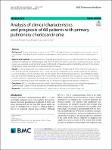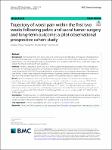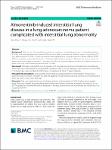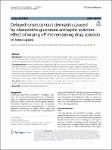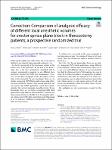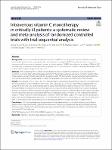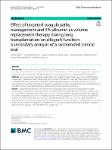Search
Author
- Daqing, Ma (3)
- Anna, Lybeck (2)
- Ashish K., Khanna (2)
- Dan, Bieler (2)
- next >
Subject
- intensive care unit (8)
- acute respiratory dist... (5)
- chronic obstructive pu... (5)
- ICU (5)
- next >
Search Results
Primary pulmonary choriocarcinoma (PPC) is a highly malignant intrapulmonary tumor with a notorious prognosis. Few clinical studies have been undertaken to investigate the clinical characteristics and prognosis of PPC. |
Pain management after pelvic and sacral tumor surgery is challenging and requires a multidisciplinary and multimodal approach. Few data on postoperative pain trajectories have been reported after pelvic and sacral tumor surgery. The aim of this pilot study was to determine pain trajectories within the first 2 weeks after surgery and explore the impact on long-term pain outcomes. |
To determine the diagnostic accuracy of a nanopore sequencing assay of PCR products from a M. tuberculosis complex-specific region for testing of bronchoalveolar lavage fluid (BALF) samples or sputum samples from suspected pulmonary tuberculosis (PTB) patients and compare the results to results obtained for MGIT and Xpert assays. |
With the use of targeted drugs in lung cancer patients, targeted drug-induced interstitial lung disease (ILD) has attracted more and more attention. The incidence, time, and severity of different targeted drug-induced ILD vary. Almonertinib/HS-10296 is a third-generation epidermal growth factor receptor-tyrosine kinase inhibitor (EGFR-TKI). Post-marketing safety and effectiveness of almonertinib have been confirmed. The reported adverse events of almonertinib were mainly an increase in creatine phosphokinase, aspartate aminotransferase, and alanine aminotransferase, and onset of rash. Almonertinib-induced ILD is rare. |
Caudal epidural block (CEB) is a kind of epidural anesthesia in which local anesthesia is injected through the sacral hiatus into the sacral epidural space to block the sacral nerve and temporarily paralyze the area it controls [1]. CEB may be beneficial in anorectal surgery because its use may extend postoperative analgesia, which reduce the need for systemic analgesics and their potential side effects [2, 3]. Although CEB has many clinical applications, it is sometimes difficult to ascertain the anatomical location of the sacral hiatus and the caudal epidural space, particularly in adults [4, 5]. |
Olanexidine glucuronide (Olanedine®), an antiseptic solution may cause skin dermatitis around one week after disinfection. Although removal after the procedure is recommended to avoid skin dermatitis, whether it is effective for preventing skin dermatitis has not been documented in detail in the literature. |
I read with great interest the article “Association between blood pressure and the risk of biopsy-induced endobronchial hemorrhage during bronchoscopy” by Wang et al., It provides great insight into the hypertension and bleeding risk in a specific category of bronchoscopy procedure—endobronchial biopsy, in a specific population—lung malignancy. But I would like to offer the following comments. |
Correctly cite ‘To our knowledge, there are no studies comparing ESPB block applications using different local anesthetic volumes after thoracotomy. However, in a case series with different volumes, it was reported that the block level increased up to 9 dermatomes in a case in which 30 ml of local anesthetic was applied [4]. In studies conducted to determine the optimal level at which volume expansion can be achieved, it has been shown that this volume varies in a wide range such as 2.5 mL/ and 6.6 mL per dermatome, while the median value is 3.4 mL [5]’ should be in the form. |
A recent landmark randomized controlled trial (RCT) in septic patients demonstrated an increased risk of death and persistent organ dysfunction with intravenous Vitamin C (IVVC) monotherapy, which represents a disparate result from previous systematic reviews and meta-analyses (SRMA). We performed an updated SRMA of IVVC monotherapy to summarize and explore heterogeneity across current trials and conduct trial sequential analysis (TSA) to guard against type-I or type-II statistical errors. |
Primary graft dysfunction (PGD) after lung transplantation (LuTx) contributes substantially to early postoperative morbidity. Both intraoperative transfusion of a large amount of blood products during the surgery and ischemia–reperfusion injury after allograft implantation play an important role in subsequent PGD development. |

